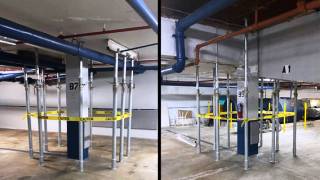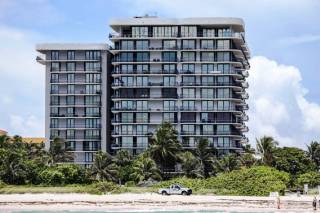Temporary structural supports have been added to areas in the underground garage of Champlain Towers North, seven months after its sister tower collapsed in the middle of the night. The shoring was installed in mid-January despite assurances months earlier from the condo board that the building was structurally sound. The supports were put in place “in an abundance of caution” as part of an ongoing inspection by a structural engineer, and will remain “until the columns are reinforced,” according to a Jan. 19 notice from the condo board to unit owners.
|
Shoring is visible around at least 11 columns at Champlain Towers North, sister building to the Champlain Towers South condo that collapsed in June 2021. |
Residents of Champlain North were given the option to voluntarily evacuate with resources provided by the Miami Foundation. Most stayed. “If Surfside had any doubts about the safety of this building they would have evacuated us six months ago,” said Naum Lusky, president of the Champlain North condo association.
|
Surfside’s Champlain Towers North at 8877 Collins Ave. is seen on Saturday, June 26, 2021, two days after the similarly designed Champlain Towers South partially collapsed. |
Kilsheimer told the Herald he had done only a visual, walk-through inspection, and took limited concrete samples. He didn’t provide the results of tests on those samples and denied giving the building a clean bill of health. “We didn’t do a full evaluation of anything in that building, I was giving people my opinion based on my experience of what I saw,” he said. Numerous engineers walked through Champlain South in the years before it collapsed, and while their visual inspections revealed extensive damage, none of their reports concluded the building was on the brink of catastrophic failure. In 2018, Ross Prieto, then the Surfside building official, saw one of the reports and concluded the structure was in “good shape.” Records show Champlain North hired engineer Youssef Hachem to inspect the aging condo in accordance with county regulations mandating a safety check and recertification for 40-year-old structures.
In a letter dated
Sept. 27, 2021, to the Champlain North condo board
president, Hachem said his team had completed a visual
inspection of the building, but a fuller structural
inspection was ongoing. “At this time, we are not complete
in our investigations, but we are confident the building is
safe to be inhabited,” Hachem wrote in the letter. The full
investigation would include scans to locate reinforcing
steel within the concrete, and core samples to determine the
strength of the concrete, according to the town’s
recommendations cited in the letter. Hachem did not respond
to a request for comment.
Abieyuwa Aghayere, engineering professor at Drexel
University, said that Champlain Towers North should undergo
a thorough investigation before being declared safe. “If the
engineer’s investigation is not complete, how could they
guarantee that the building is safe to inhabit — especially
given the similarity of this building to CTS,” Aghayere
said. Photos from mid-January show metal posts are now
clustered around narrow columns in portions of the Champlain
North basement near the entrance ramp and along the western
edge. The condo board president said he was unsure of the
specifics of what prompted the placement and the town didn’t
provide any details either in response to questions from the
Herald. “In existing buildings, post shores are often placed
if a structural element has deteriorated and needs to be
fixed,” Aghayere said. He said the language from the Jan. 19
condo board notice — which states the shoring will be in
place “until the columns are reinforced or support collars
are installed as needed” — suggests the condo’s engineer is
concerned about punching shear, a dangerous failure that
happens when the column suddenly pokes through the slab, as
happened on the pool deck at Champlain South.
No permit was pulled before shoring began, Surfside records
show. Surfside spokesperson Malarie Dauginikas said in a
statement the town was aware of the “precautionary,
pro-active shoring being done at Champlain Towers North” and
that the activity was approved by the town building
official. Dauginikas also said that a permit should be
required for shoring to be placed, but, in this case, the
application process was pending. On Monday, Jim McGuinness,
Surfside building official, said in a statement that he
authorized the shoring but gave no further explanation about
why it was necessary. Dauginikas said leaders from Champlain
Towers North “personally visited the town and made a verbal
request to install the shoring.” “The shoring was authorized
under the Florida Building Code and granted via verbal
request,” she said.
The building’s 40-year
recertification was due Dec. 28, 2021, but Dauginikas said
the town granted it a 90-day extension. “Shoring is just a
way to further ensure the safety of the building,” said
Lusky, the condo board president. Although he said he didn’t
know specifics, Lusky said he is confident the building is
safe and expects to receive a full engineering report within
two weeks that will detail any necessary repairs.
Politicians expressed concerns about Champlain North in the
immediate aftermath of the collapse of its sister tower.
Surfside Mayor Charles Burkett wrote to Daniella Levine
Cava, his Miami-Dade counterpart, on July 23, expressing the
town’s urgent need to investigate the collapse site “given
there is a sister building, Champlain Towers North, that is
substantially the same building.” He called the situation an
“emergency.” In an interview Friday, Kilsheimer said the
primary purpose of his visits to Champlain North was to use
the condo as a testing ground to collect clues about what
could have gone wrong at the sister building as he waited
for access to the collapse site. He clarified that he never
inspected Champlain North for safety and is not involved in
its recertification process. But he said he would have
reported any obvious signs of danger. “From the exposed and
visible conditions, I saw nothing that bothered me,”
Kilsheimer said. But without a complete engineering report,
he said he could not give a full assessment of Champlain
North’s conditions. He said he made the limitations of his
visits clear to representatives of the condo at the time. “I
said what I said. If you look at my reports, that is what I
said,” Kilsheimer said. “I knew I was talking to people that
didn’t necessarily understand engineering construction so I
made it as clear as possible,” he said. Although Kilsheimer
mentioned various activities, including scans and core
sampling, the reports obtained by the Herald through a
public records request provided no analysis of the structure
or its safety.

